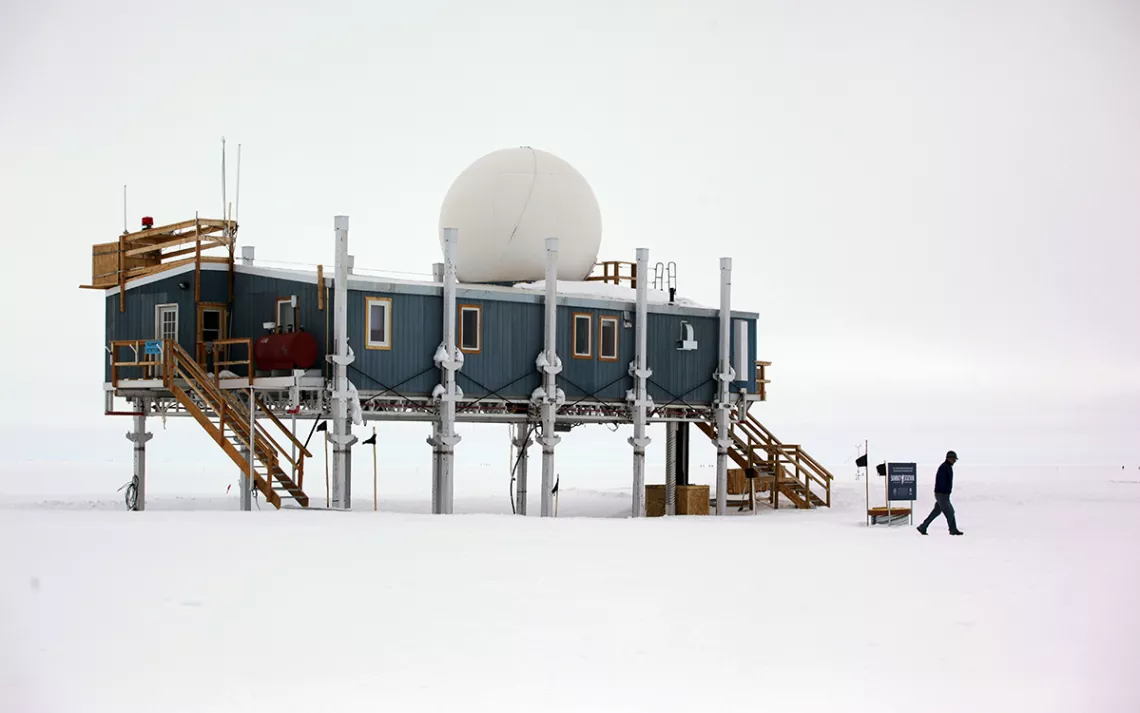Rain Fell for the First Time on Greenland’s Summit. Here’s Why It Matters.
It turns out what happens in Greenland doesn’t stay in Greenland

Summit Station | Photo by AP/Brennan Linsley
Earlier this month, instead of snow, rain fell on Greenland’s tallest point. It was the first time on record, and it was only the fourth time that temperatures there—an ice-capped expanse two miles above sea level, located in the very center of the Arctic island’s interior—had risen above freezing. For two days following the rain, 337,000 square miles of the territory’s ice sheet experienced surface melting. In total, 7 billion tons of water flooded the summit.
That rain has fallen in one of Earth’s most reliably frozen regions is an “unprecedented shock to the system,” says John Walsh, a professor at the University of Alaska Fairbanks and a scientist with the International Arctic Research Center. “This has never happened before. Something is going on in the atmosphere that’s taking us into uncharted territory.”
Greenland is a linchpin within the world’s climate system. Weather that happens there has global implications, Walsh says.
The Labrador and Greenland Seas, which wrap around the island’s eastern, southern, and western coasts, play pivotal roles in driving what Walsh calls “the global conveyor belt” of ocean currents. These seas are the world’s main centers for deep convection, a process in which colder, denser ocean water sinks and warmer water rises to the surface. This churning action fuels the flow of the world’s oceans, which in turn helps stabilize global temperatures and rainfall.
But deep convection is impeded by freshwater. Less dense than saltwater, it rests atop the ocean’s surface like a lid. When ice melts into the ocean, not only do sea levels rise, but also the convection process slows, leading to extreme weather around the globe.
This has happened before. The last ice age, which lasted from 110,000 to 15,000 years ago, was hardly a uniform global freeze. Instead, temperatures fluctuated rapidly all over the world; the Northern and Southern Hemispheres alternated between long stretches of warming and cooling. In 2016, scientists found evidence that suggested this out-of-sync, drastic weather was caused in large part by a major slowing of the oceans’ currents at the time, particularly those near present-day Greenland.
“The more that Greenland melts, the more freshwater will sit on top,” Walsh says. “The evidence now seems to be suggesting that we’re already seeing a slow-down of the conveyor belt. The combination of freshening and warming are a double whammy and a real concern.”
This feedback loop contributed to the rain event at Greenland’s summit. Ocean waters have been warmer and fresher than normal this summer, which primed the air moving inland for rain instead of snow.
The distinction between ice and snow is significant in the Arctic, says John Moore, a geophysicist specializing in glaciology and a professor at the University of Lapland. In locations like Greenland’s interior summit, where rain had never fallen before, “ice” is technically a misnomer. The topography is really composed of layers and layers of snow, which over time, and under great weight, has become densely packed, though still with tiny pockets of air.
But now, meltwater and rain are freezing into solid layers of ice that take many weeks, if not months, to naturally break up. Nobody lives near the Greenland summit, but in other parts of the Arctic, these freezing rain events are wreaking havoc on both natural and urban ecosystems.
Thousands of reindeer, unable to dig through frozen rain to reach the vegetation they eat, have starved in the past few years. And Indigenous communities throughout the Arctic, who depend on reliable freezing and melting seasons, and on animals who migrate according to weather, find transport across ice sheets—rather than snow—incredibly challenging.
The rain event at Greenland’s summit occurred just five days after the Intergovernmental Panel on Climate Change released its Code Red for Humanity climate report and coincides with sweeping wildfires throughout Greece and Turkey, historic drought in both southern Africa and the American West, and record-high temperatures worldwide. According to Moore, Greenland’s rain and these events are interconnected.
“Like a pan of water boiling on the stove, you turn the heat up and all sorts of chaotic circulations take place,” says Moore. “What happened in Greenland is evidence of this chaos.”
“The Greenland rain event is something not even scientists expected,” Walsh says. “So what else is out there? That’s the real concern here. There could be some surprises that we’re not anticipating at all.”
 The Magazine of The Sierra Club
The Magazine of The Sierra Club



